Creating and running a Project Management Office (PMO) that consistently delivers value in our VUCA world (i.e., Volatile, Uncertain, Complex, Ambiguous) is a challenge. Of course, many different schools of thought address this challenge. But they all do this with varying, if not insufficient, levels of success.
However, imagine now that you operate a PMO that is lean, agile, and state-of-the-art, and that delivers a measurable contribution to your organization’s success. You may find that this PMO shares several characteristics with hummingbirds. The hummingbird is indeed the very symbol of what a lean, agile, and effective PMO is.
In this article, you will find 10 characteristics agile PMOs share with these birds. Hummingbirds:
- Belong to a variety of species
- Are among the smallest of birds
- Love flowering plants they cross-pollinate
- Fly with breathtaking agility
- Are very resistant to fatigue
- Acquire vocalizations through imitation
- Have a high spatial resolution in lateral and frontal visual fields
- Keep their head positions stable in turbulences
- Can enter hibernation-like states
- Have a lifespan of 3 to 5 years
- Conclusion
Now, before reviewing these characteristics, watch this beautiful video from National Geographic and admire the extraordinary behavior of the hummingbird in turbulent times.

Read now: Why have a PMO? Duties, Advantages, and Added Value of a Project Management Office
1. Hummingbirds Belong to a Variety of Species
Hummingbirds are small and agile birds from the Americas. They constitute the family Trochilidae. Hummingbirds fall into nine main clades, the Topazes, Hermits, Mangoes, Brilliants, Coquettes, Patagona, Mountain Gems, Bees, and Emeralds. They count between 325 and 340 species.
So are PMOs. PMOs can belong to several branches or clades (usually 3-7), from Project or Program Management Office to Portfolio Management Office. It can be an Enterprise Project Management Office or a Center of Excellence in Project Management. It may even be a Strategic Initiative Management Office. Many today are in charge of large (digital) transformations, as Transformation Management Offices.
Special Download: 10 Vital PMO Success Factors (PDF file)
Please fill in the form.
* Required Fields | Data Protection
These branches count a large variety of situations defined by the domains, the level, the scope of control or the experience and capabilities they show. One size does not fit all. Surely, this diversity contributes to agility.
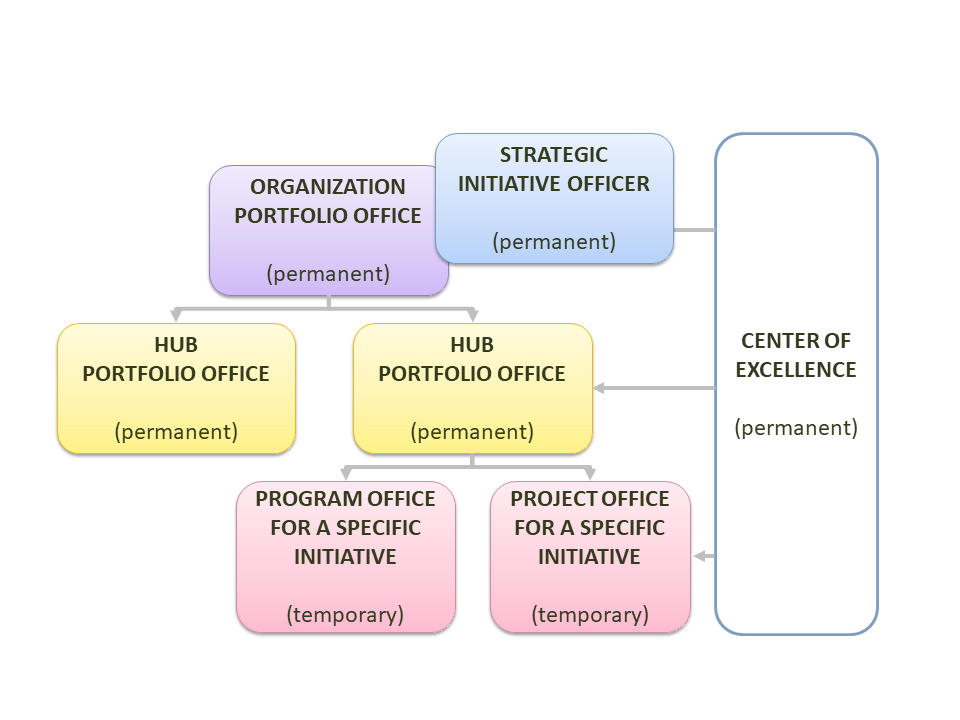
Identifying and counting all PMO individuals in the world is an impossible task. Here are a few examples. Global 500 companies may have several tens of different PMOs, from business unit PMOs through to Information System Portfolio Management Offices. LinkedIn gives more than 1,000,000 results when you search for people with the word “PMO” in their title. At the same time, Google gives 98,100,000 results for a search with “PMO” as a keyword.
Find out more about the different PMO types in our article about successful PMO setup.
One difference though between hummingbirds and PMOs is that PMOs are everywhere in the world and not only in the Americas. LinkedIn again finds 260,000 PMOs in the US, and hundreds of thousands outside the Americas. You can be sure that they all have an exciting diversity based on their culture, their history, and their role in their organization.
Tips:
- Differentiate the PM Office and the PM Officer.
- Clarify what your organization calls a PM Office with a family (PMO) and clades (branches) like Project MO, Program MO, Portfolio MO, Strategic Initiative MO, Transformation MO, PM Center of Excellence.
- Consider the huge variety of individuals serving as a PM Officer; clarify their mission, their capabilities, and their personal development needs.
- Insist on the common purpose of all: to support a project portfolio, a transformation, a program, or a project.
Special Download (PDF): What are typical PMO Functions? (+ their importance)
This article provides you with a good comparison as well as ideas for functions you could consider next for your PMO. Please fill in the form to download.
* Required Fields | Data Protection
2. Hummingbirds Are Among the Smallest of Birds
They are among the smallest of birds, most species measuring 7.5–13 cm (3–5 in) in length. Female hummingbirds tend to be larger, requiring more energy, with longer beaks that allow for more effective reach into crevices of tall flowers for nectar. Thus, females are better at foraging, acquiring flower nectar, and supporting the energy demands of their larger body size.
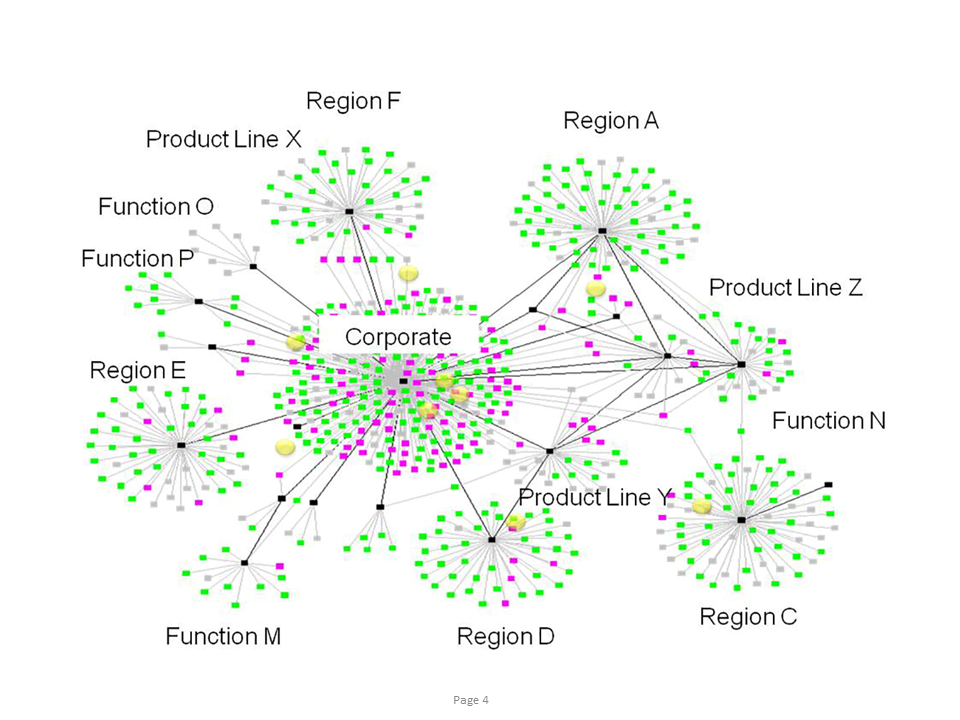
Agile PMOs are generally very small too. Can you imagine a heavy PMO being agile like a hummingbird? With an industrial market leader, the agile Enterprise PM Office imitates a flock of birds by coordinating 35 decentralized small PM Offices and Officers. The graphic above depicts such an example. The most effective PMOs I have seen are made of only very few people.
Learn about the Strategic PMO of the Future in this article.
In another very large worldwide transformation, only two people made the PMO. However, these two individuals here also built and animated a community of tens of decentralized lean PMOs. Each of them was well embedded in their local organization and highly dedicated, motivated, and professional. They acted locally as proxies of the Program Management Office.
Tips:
- Create agility in your organization by preferring a swarm of small, distributed, and diverse PMOs to a large monolithic PMO.
- Make these PMOs build connections, form an organization-wide community of practice, and share their diversity.
- Impact the organization by working on the interactions between the local PMOs.
Special Download: Agile, Traditional or Hybrid Project Management? (PDF file)
Please fill in the form.
* Required Fields | Data Protection
3. Hummingbirds Love Flowering Plants They Cross-Pollinate
Hummingbirds love nectar-bearing flowering plants. They depend on flower nectar to fuel their high metabolisms and hovering flight. Many plants pollinated by hummingbirds produce flowers in shades of red, orange, and bright pink.
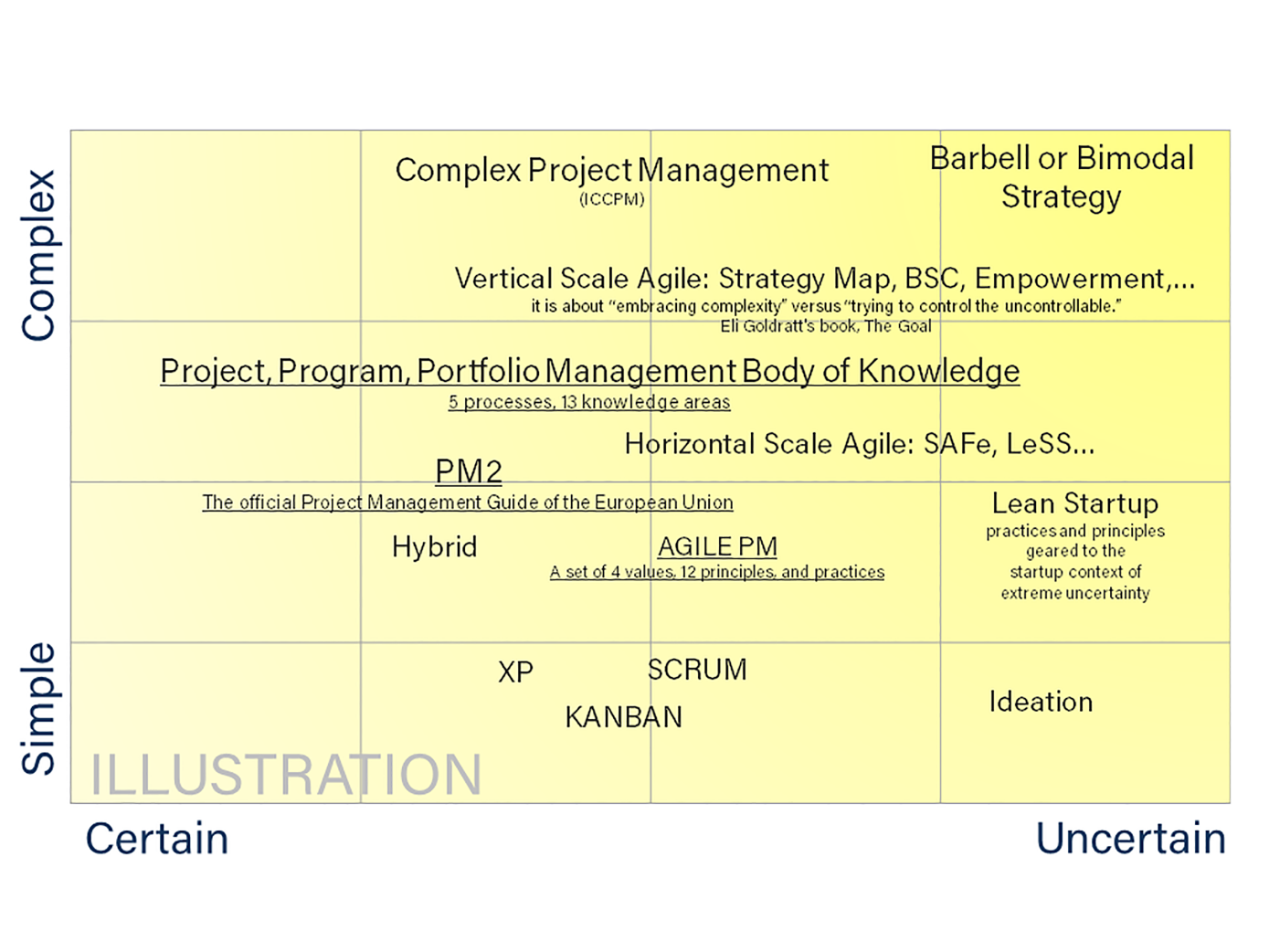
PMOs love great, diverse, and ambitious projects. There is nothing worse than a dull project for which the PMO has neither challenge to overcome nor great purpose to contribute.
Most PMOs are temporary. Once their assignment concludes with the end of a project, they move to another endeavor. A PMO going from an exciting project to another one cross-pollinates these projects.
At the same time, they study and share a variety of project management approaches, from lean start-up to mega-project management or strategic initiative portfolio management. Their mindset is constantly open to the most adapted solutions.
Find a useful information on hybrid project management in this article.
They even master the hybridization of several different approaches during the same project. For example, they introduce lean start-up approaches upstream, agile approaches later, and waterfall approaches as soon as most uncertainties disappear.
Tip:
- Make sure your PMO is able to understand and draw upon a variety of bodies of knowledge, methodologies and tools.
- Use the available approaches according to the level of the project (scope, depth, duration…). Some approaches work well at the macro-level, others at the micro-level. Do not conflate them.
- Here again, consider the interactions between all.
4. Hummingbirds Fly with Breathtaking Agility
The hummingbird has a number of adaptations that allow it to fly with breathtaking agility and precision. They can fly straight, in reverse, upwards, downwards, and even upside down. Of all the known species of birds, the hummingbird is perhaps one of the most iconic because of its unique ability to hover. When they hover, hummingbirds move their wings more like a buzzing insect than a flapping bird. Some experts found that hummingbirds’ wings have aerodynamic properties similar to helicopter blades. They hover in mid-air at rapid wing-flapping rates, which vary from around 12 beats per second in the largest species, to in excess of 80 in some of the smallest. Of those species measured in wind tunnels, the top speed exceeds 15 m/s (54 km/h; 34 mph) and some species can dive at speeds in excess of 22 m/s (79 km/h; 49 mph).
If you want to act like an agile PMO, become capable of flying straight, in reverse, upwards, downwards, and even upside down during the course of your endeavor. Such a PMO can hover and support complex projects with a remarkable agility allowing it to navigate the most VUCA environments (Volatile, Uncertain, Complex, Ambiguous).
Curious about agile project management and where it is appropriate? Read this.
They interact with stakeholders in every direction, vertically (up and down), laterally (with different functions, geographies, roles). They, like the Russian Sukhoi Pugachev’s Cobra maneuver, avoid opponent maneuvers and missiles.
A Program Management Office at a client was able to counter a deadly opposition from the company-internal consulting group. While the latter tried to make the Program Steering Committee impose a linear fixed roadmap, the former chose a very flexible serendipitous strategy. The PMO used a diversionary tactic to get the approval for their flexible strategy.
Sign up for our blog newsletter now and never miss another blog post.
Agile PMOs also study and learn the laws of physics. For example, they learn that a controlling system must be nimbler than the system it pretends to control. The management system they implement must meet this obligation.
A complex transformation PMO installed a decision-taking process with the Executive Committee that was much faster and more effective than the legacy governance process. This gave a definitive advantage to the transformation over any other existing management system.Finally, they especially learn the laws of thermodynamics.
For example, they learn that organizations are complex adaptive systems. As such, organizations dissipate their energy and memorize information (since Shannon, we know that energy and information are equivalent). And they do this by constantly increasing the speed with which they dissipate them (exactly like our universe is expanding).
The consequence of this fact pushed a PMO, though working in a very secretive company, to build a very open and efficient communication system from and to all stakeholders. So, they support their projects, programs or portfolios with a very open mindset and the largest possible information exchange with their outside world.
Tip:
- Implement a management system that makes you more complex than the system you need to control
- Exchange information witho the outside world as fast as possible. Speed is a key success factor.
- Replace linear deterministic and inflexible roadmaps by flexible opportunistic serendipitous strategies.
5. Hummingbirds Are Very Resistant to Fatigue
Hummingbirds also have the ability to simply hover for very long periods of time. During flight, oxygen consumption per gram of muscle tissue in a hummingbird is about 10 times higher than that measured in elite human athletes. Hummingbirds are rare among vertebrates in their ability to rapidly make use of ingested sugars to fuel energetically expensive hovering flight.
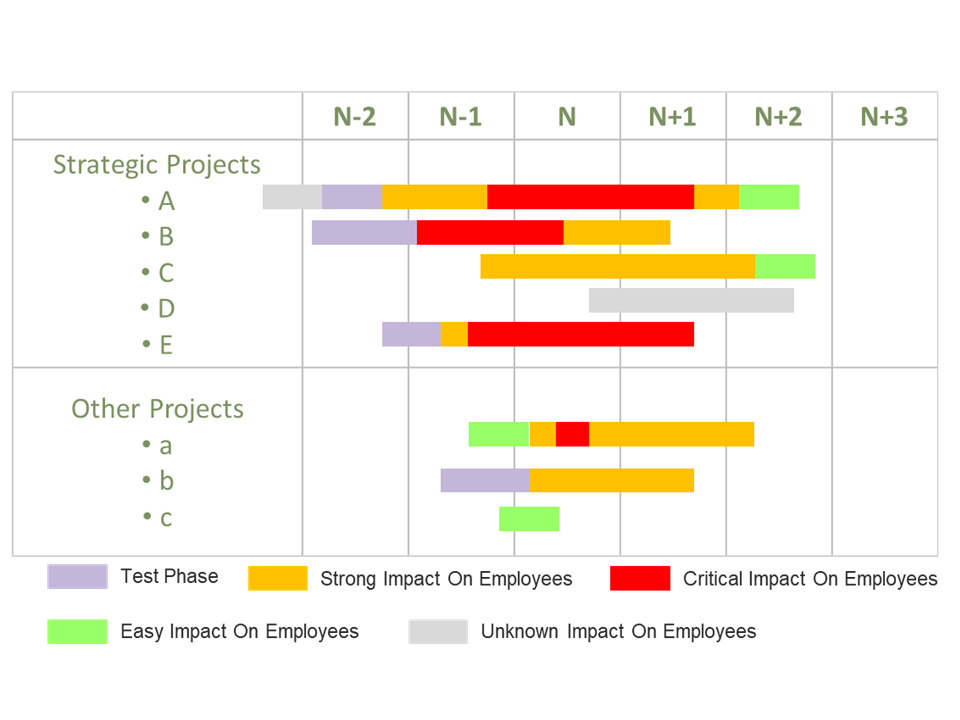
Long projects are one of the key challenges of project teams. Some projects last indeed for a very long time (sometimes more than 10 years). At the micro-level, some meetings are very long, too (several days). If everyone knows about the daily stand-ups, everyone also endures much longer meetings (some over one week).
So it is important that PMOs as well as team members demonstrate the ability to “hover” for very long periods of time both at the macro-level and at the micro-level. Agile PMOs can anticipate the project fatigue created by the change impact on themselves as well as on their stakeholders.
The figure above shows a typical example of project fatigue analysis. Most employees in a large company work simultaneously on a variety of projects, either as a direct contributor or as a user. In this example, the PMO interviewed a variety of employees in a given population and evaluated their project fatigue due to all projects in which they were engaged. Then, the PMO picked up the ability to reorganize the project portfolio to reduce this fatigue by making the concerned portfolio and project sponsors reconsider their plans. This graphic helped a company rationalize its portfolio of projects before launching a new important program.
They can also recognize this fatigue and propose to adapt the project management style. And they increase the comprehension for all stakeholders of what happens. This makes people feel more comfortable with the project.
Tips:
- Your first goal as a PMO is to survive. This is the only way you can bring a project to success. Maintain your work-life balance (physical and mental).
- Apply the same rule to your stakeholders and to your team members.
- Apply what is called the “via negativa” by eliminating unnecessary, redundant, idle, or poor activities and projects before launching new ones.
6. Hummingbirds Acquire Vocalizations through Imitation
Consisting of chirps, squeaks, whistles and buzzes, hummingbird songs originate from at least seven specialized nuclei in the forebrain. A genetic expression study has shown that these nuclei enable vocal learning (ability to acquire vocalizations through imitation), a rare trait known to occur in only two other groups of birds (parrots and songbirds) and a few groups of mammals (including humans, whales, dolphins and bats).
PMOs also imitate their peers as well as other important professionals. They learn the human dynamics of their project stakeholders. These human dynamics comprise a variety of domains. Among them, you find knowledge of languages, history, cultures, human behaviors, cognitive biases.
They learn the capabilities of the professional sectors they support. In a large industrial company, many of the most successful PMOs had an extensive previous experience of R&D, or Marketing and Sales, or Industry.
These PMOs also use tools, soft or hard, that help them adjust their work to the particularities of the context. For example, PMOs supporting a digital transformation use very specific tools that would not serve as well in the building of a new manufacturing plant and vice versa.
You might also like our 7 Measures to Increase PMO Acceptance.
Here are a few practical examples from top-notch PM Officers.
- They practice several foreign languages.
- They adapt their interaction style to the cultural preferences of their stakeholders.
- They build relationships first where this is important.
- They focus on actions and results where and when appropriate.
- They navigate between short and long term, between different stakeholders’ statuses, between individual and group attitudes.
- They even use linguistic analysis to catch hidden characteristics of the initiatives, reports, or communication.
Tip:
- Great PMOs work primarily on the relationships with and between stakeholders.
- “Hummingbird” PMOs learn their stakeholders’ style and adjust their attitude as required to make the interrelationship fruitful.
- They adapt their interaction style to the cultural traits (individual and group) of their stakeholders (language, behavior, mutual understanding).
- They may even use linguistic analysis to catch hidden characteristics of the initiatives, reports, or communication.
7. Hummingbirds Have a High Spatial Resolution in Lateral and Frontal Visual Fields
During evolution, hummingbirds have adapted to the navigational needs of visual processing while in rapid flight or hovering by development of an exceptionally dense array of retinal neurons allowing for increased spatial resolution in the lateral and frontal visual fields. The enlargement of the brain region responsible for visual processing indicates enhanced ability for perception and processing of fast-moving visual stimuli, which hummingbirds encounter during rapid forward flight, insect foraging, competitive interactions, and high-speed courtship. Hummingbirds can even see wavelengths into the near-ultraviolet.
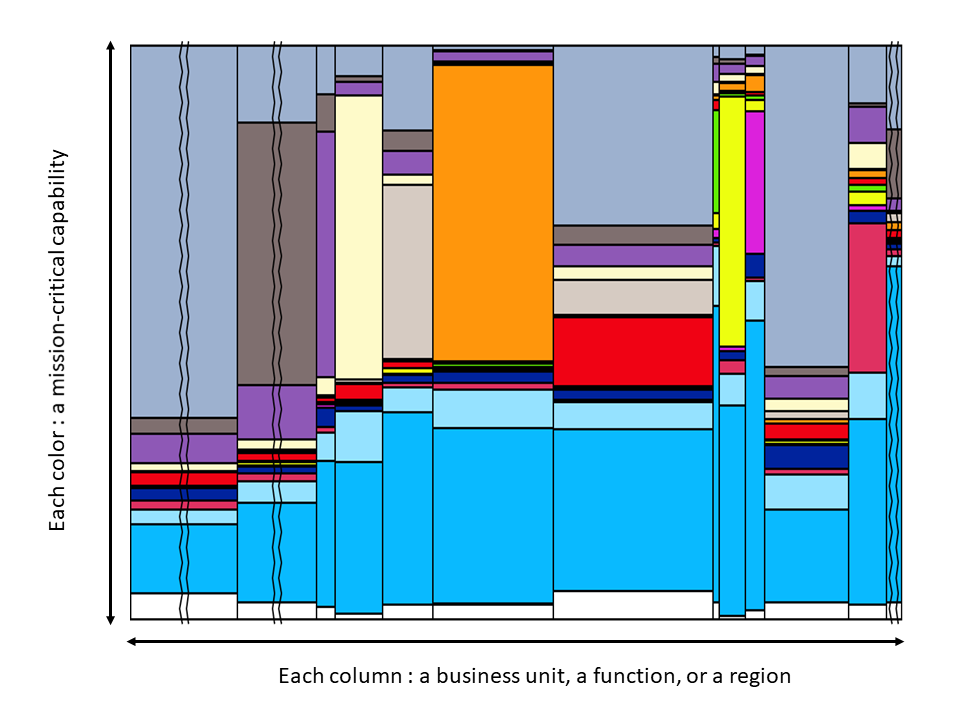
The more complex a project, the more VUCA an environment, the more information is important for a PMO. Yet, there is a limit to the amount of available information, and pertinent information must be extracted from the huge noise that too much information represents.
Complex systems are also highly sensitive to initial conditions. This phenomenon bears the name of “butterfly effect”. Early information gathered upstream is vital. Early business intelligence is key to avoiding big mistakes later.
Complex systems are also unpredictable to targets due to the impossibility to get complete information on their behavior, micro and macro. This requires both getting the most precise understanding of how a system works and developing innovative strategies adapted to an uncertain and volatile environment.
Here is a practical example. A Global 500 company wanted to focus its teams on customer-centricity. The above graphic shows the mission-critical capabilities across the entire organization (a macro-view) required to deliver successfully such a transformation that included employee training, new information systems, and new processes.
The PMO that built this graph, called Marimekko, was able to identify key gaps in some vital customer-facing functions (generating a micro-analysis) as well as over-capabilities in less critical functions.
Finally, a hummingbird perfectly memorizes the map of its territory, all existing flowers, and, most importantly, all flowers recently visited. The hummingbird thus does not lose time visiting again a flower not yet replenished with nectar. In the same manner, agile PMOs have “single versions of the truth” available 24×7. The important characteristic is their availability across the organization at any time. If the data were wrong, they would not last long when visible to everyone.
Tips:
- Getting access to pertinent information is vital. A PMO accessing a large pertinent amount of data gains a real competitive advantage.
- Separate useful data from the background noise.
- Transform this data into information (for example useful in decision-making) and knowledge (for example to be capitalized and used in other projects).
8. Hummingbirds Keep Their Head Positions Stable in Turbulences
During turbulent airflow conditions created experimentally in a wind tunnel, hummingbirds exhibit stable head positions and orientation when they hover at a feeder. In natural settings full of highly complex background motion, hummingbirds are able to hover precisely in place by rapid coordination of vision with body position.
The agile PMO demonstrates the same vital capability to maintain the head above water. Turbulences strike a project. Uncertainty and instability shake the course of a project. Conversations with colleagues, during meetings, or with executives can be difficult. However, the agile PMO stays confident, calm, and focused on the mission.
During the realization of an important transformation program within a market leader, a small group of executives opposed the approach that was going to endanger their personal status. Politics developed. They challenged covertly the program leader’s competency. The program leader and the PMO stood very firm as an indefectible team until the opposition disappeared with the first positive results.
Tips:
- No amount of data will ever guarantee the predictability of results. Therefore, the PMO must study and learn flexible and adaptive strategies.
- Uncertainty is a fact of life. It is a source of risks and opportunities. Both need to be addressed.
- Some uncertainties have a bell curve type of probability. Their forecast makes sense. Yet, other opportunities have a long tail type of probability. Do not try to forecast them. Instead, work only on their potential consequences.
9. Hummingbirds Can Enter Hibernation-Like States
To conserve energy when food is scarce, and at night when not foraging, hummingbirds can go into torpor, a state similar to hibernation, slowing metabolic rate to 1/15th of its normal rate.
PMOs may go through periods of desert. Projects may be missing, slow moving, or waiting for key decisions. They may work on an initiative that is stopped, temporarily or not.
Imagine you support a construction project in a beautiful Italian town. Imagine also that when workers begin to dig the foundations, they find bones from ancient Rome. No doubt the project will be stopped, and archeologists will take precedence over construction work.
Something worse happened to a PMO in charge of a Marketing and Sales portfolio. Her new boss did not believe that a PMO would add value. He did not express it clearly. Conversely, he let the situation rot. Rapidly, the PMO had no seat at any table anymore. The Marketing and Sales project managers also ignored her more and more also, following the attitude of their boss. This PMO spent horrendous months of solitude until she quit her current job to find a new one in a more welcoming environment.
In these situations, it is time for the PMO to hibernate, if not to flee or fight. The expert PMO understands time preference and knows to be patient now and impatient later.
Most great leaders spent a long time in exile, in prison, or in a desert. Do not worry if it happens to you.
Tip:
- Momentary adversity is a fact of life.
- Do not fear loneliness, silence, or desert in those cases. These are all opportunities for resourcing, learning, introspecting, waiting for maturity, and at the end for preparing a better future.
10. Hummingbirds Have a Lifespan of 3 to 5 Years
Many hummingbirds die during their first year of life, especially in the vulnerable period between hatching and fledging, those that survive may occasionally live a decade or more. Among the better-known North American species, the average lifespan is probably 3 to 5 years.
This does not seem too different from PMOs’ lifespans.
First, let us differentiate between the lifespan of a PM Office and the lifespan of a PM Officer.
PM Offices are mostly temporary when they support a project or a program. Conversely, they are built to last a long time (or to be permanent) when they deal with an organizational strategy, a portfolio of projects and programs, or a center of excellence.
PM Officers have a different attitude regarding time.
Another interesting read: How to Create KPIs for the PMO
Some PMOs “die” very early. There are two reasons for this. Firstly, this is frequently the case when they lack the expected capabilities. Their hiring process is neglecting key characteristics, like their level of capabilities on each of the three dimensions of the Talent Triangle (technical, business, and leadership).
But, secondly, most of short lifespans happen when project leaders and PM Officers do not rapidly perform as a close-knit buddy system. The PM Officer then leaves the PM very early. This is especially the case when weak project managers hold their PMO accountable for a lack of performance in the project.
Other PM Officers last a few years. They start and finish with the project.
A key difference though, compared to hummingbirds, is that PMOs have the privilege to find new lives (by finding a new project to support) every time one is gone.
Still better, PMOs have an increasingly exciting career they can manage with agility. They have opportunities to support ever-larger domains and endeavors (think of the PMOs in mega-projects or consider Enterprise PMOs). They master more and more state-of-the-art approaches to project management (look at the recent progress in project management science). These PMOs have a larger scope of responsibilities. They may also evolve from PMO roles to PM roles and back to PMO roles.
Top-notch Centers of Excellence are often communities of such seasoned individuals. They all get truly great personal development and satisfaction. And this is really what I wish for you.
Tip:
- Separate the lifespan of a PMO as an organization and the lifespan of a PM Officer as an individual.
- Adjust the former to the organizational needs and the latter to your personal development needs.
- In a bullish environment, stay as long as possible. In a bearish environment, take your loss and leave as soon as possible. This also is agility.
Conclusion – Why Agile PMOs Are Comparable to Hummingbirds
The hummingbird is a symbol of several key characteristics an agile PMO should demonstrate. A PMO is dedicated to a mission. Its characteristics only serve to fulfill this mission successfully.
If you had only three characteristics to focus on, these three would make it:
- Be lean, decentralized, and work as a close-knit community with other PMOs.
- Develop a very large visual field within and outside your domain, at different scales, and different time horizons.
- Become stable in turbulences thanks to solid personal soft skills, the support of your community, and a flexible adaptative strategy.
Do you agree? Let me know by leaving a comment below.
To your continued success
Philippe Husser
Do you have experience with agile PMOs? Is there anything you would like to add? Please leave a comment below.
Subscribe to TPG BlogInfo: Never miss new practice-oriented tips & tricks
Every other week: Receive practical tips in TPG blog posts written by recognized experts in project, portfolio, and resource management.
* Required Fields | Data Protection
Philippe Husser is a consultant, a speaker, and an author.
He published a book helping CEOs, project leaders and PMOs to better thrive in a VUCA world: The High-Impact PMO. He writes articles in the domain of complex project management. And he delivers training sessions within development programs for high potentials in large companies.
Previously, Philippe developed and lead the Enterprise PMO at Michelin with a global Progress Initiative Portfolio Management System, a range of diverse Project Management Approaches, and a community of decentralized PMOs in Business Units, Functions, and Regions. Before, he held Transformation Program Management roles in several global Aerospace and Defense companies.
Finally, he is animating a LinkedIn network of 31000+ followers in the domain of project management. He has been the Michelin representative in the PMI Global Executive Council.
More detail about Philippe Husser on LinkedIn. You can also contact him by e-mail or phone (+33 6 07 34 10 16).
Are you interested in agile tools? Please check out this article: Quickly Compare 10 Top Agile Project Management Tools








